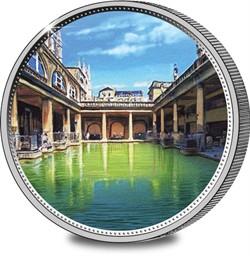-no-button.jpg)
 |
Location: City of Bath
Date completed: c. 60-70 AD
Designers/builders: Initially Romans, rebuilt to the designs of
architects John Wood the Elder and Younger in the 18th
century
Function: Hot springs and communal baths
|
The Roman Baths, in the appropriately named city of Bath, are a
major tourist attraction, drawing one million visitors a year. They
are a historic link with our Georgian and Roman past. Baths
were a central element of Roman culture, important for socialising
as well as cleansing. Most cities and larger villas would have
their heated baths. Perhaps, however, the Roman Baths should be
called the "Celtic Baths". The Celts were the first to build a
shrine on the hot springs that surface in the area, dedicated to
the goddess Sulis. Indeed the Romans, respectful of existing gods,
called the city they built there "Aqua Sulis" ("The waters of
Sulis"). The Roman temple was started shortly after the Roman
occupation in 60-70 AD, with the bathing facilities being extended
over the next 300 years. After the Romans left Britain in the early
fifth century, the baths silted up and the buildings fell into
ruin. Over the centuries, locals built baths over the hot springs.
In the 18th century the father and son architects, both John Wood,
designed the neo classical building that houses the spring. The
Grand Pump Room is still in use for visitors taking the waters
(containing 42 minerals!) and for social functions. The Victorians
expanded the complex, following the design scheme established by
the Woods. Today the Roman Baths complex is a fascinating
combination of excavated and restored Roman remains, together with
Georgian, Victorian and modern facilities. The four main
attractions are the Sacred Spring, the Roman Temple, the Roman Bath
House and the Museum. The Roman baths are below today's street
level.
The secret of Bath's 2,000+ years of healthy bathing lies in the
hot water springs. These rise from aquifers sitting between 8,900
and 14,100 feet (2,700 m and 4,300 m) below ground where geothermal
energy raises their temperature almost to boiling point. Pressure
drives the water to the surface, where it emerges at a temperature
of 46o C (114.8o F). Swimming is no longer permitted in the pool
due to health concerns, though a recent bore hole provides safe,
clean water for drinking.